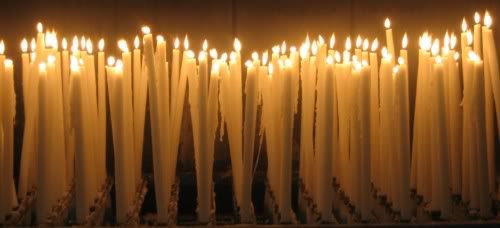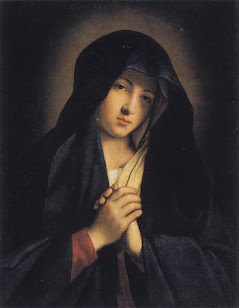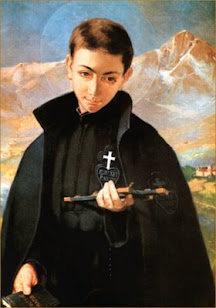“The saints must be honored as friends of Christ and children and heirs of God, as John the theologian and evangelist says: ‘But as many as received him, he gave them the power to be made the sons of God....’ Let us carefully observe the manner of life of all the apostles, martyrs, ascetics and just men who announced the coming of the Lord. And let us emulate their faith, charity, hope, zeal, life, patience under suffering, and perseverance unto death, so that we may also share their crowns of glory.”
Today, December 4, we celebrate the feast day of Saint John Damascene (John of Damascus, 676-749), hymn-writer, defender of icons, and Doctor of the Church. Saint John is considered the last of the four fathers of the Eastern Church. He devoted himself to religious poetry, theological arguments in defense of Church doctrine, and refutation of heresies. A prolific writer, many of his works remain, including beautiful canons on the Assumption of Our Blessed Mother, Easter, and the Ascension. His eloquent defense of icons and Christian art earned him the title, “The Doctor of Christian Art.” Saint John is famous for having had said:
”Show me the icons that you venerate, that I may be able to understand your faith.”
John was born in Greece to a Christian family who lived amongst the Saracens. His father was a civil authority who one day stumbled upon a group of Christian captives, sadly sitting in the town square. Among the group was an Italian priest who had been condemned to slavery. John’s father ransomed the priest, employing him as John’s tutor. Almost immediately it was apparent that John was of incredible intellect, and with the guidance of the ransomed priest, made extraordinary progress in his studies. John mastered grammar, philosophy, rhetoric, mathematics, music, poetry, and astronomy. His love, encouraged by both his tutor and his father, however, was theology. John quickly became renowned for his considerable—nearly complete—knowledge of theology and the theological method.
Upon the death of his father, the caliph who had employed him, appointed John as his principle advisor, the Grand Vizier. When his father died, the caliph made of him his principal counselor, his Grand Vizier. Saint John vigorously opposed the ferocious Iconoclast persecution instigated by the Emperor of Constantinople, Leo the Isaurian. He distinguished himself, with Saint Germain, Patriarch of Constantinople, in the defense of the veneration of sacred images, saving many from destruction.
Emperor Leo was unaccustomed to such vocal opposition, and found himself quite irritated with the learned and holy man. The emperor hatched an elaborate plot, which eventually convinced Saint John’s caliph that he was a traitor. It was ordered that his right hand be cut off in the public square, and the severed hand be attached to a post for all to see. This was done without ceremony or complaint by Saint John, who had not been allowed to defend himself against the charges. However, Saint John later acquired the severed hand, and prayed to the Blessed Virgin that he might be able to continue writing the praises of Her Son and Herself. Upon awaking the following morning, he found his hand re-attached, with no trace of pain. A permanent score about his wrist remained the rest of his life, marking the site of the miracle.
This miraculous healing convinced all that John had been telling the truth, and he was re-instated to his position. However, the miracle had also convinced John that his calling was in service to the Church through his writings. He promptly gave all he had to those who needed, and retired to the Monastery of Saint Sabas near Jerusalem. The remainder of his years were spent in prayer, composition of hymns and poems, and apologetics. Included in these works was “The Fountain of Wisdom,” the first real compendium of Christian theology. He died at the monastery at the age of 104, and was buried near the doorway of the church.
Saint John Damascene had great faith—a faith grounded in the theology and doctrine of the Church. One of the Church’s greatest defenders, he drew upon his God-given intellect to defend not only the teachings of the Church, including the Assumption of Our Blessed Mother, but to expand the manner in which we worship and praise the Lord—through poetry, through hymns, and through adapting music to use during the Liturgy. The faith of Saint John, evidenced by the miraculous healing of his hand, reminds us that all things are possible with the Lord, through the intercession of Our Blessed Mother.
Confirm our minds, O Lord, in the mysteries of the true faith, set forth with power by your servant John of Damascus; that we, with him, confessing Jesus to be true God and true Man, and singing the praises of the risen Lord, may, by the power of the resurrection, attain to eternal joy; through Jesus Christ our Lord, who lives and reigns with you and the Holy Spirit, one God, for evermore.
Day 338 of 365
Prayer Intentions: Courageous lives of faith centered on the Lord.
Requested Intentions: Successful passing of examination; Employment for Son (J); Healing of a family and son (S); Successful marriage (G); End to husband’s addictions; Son’s employment (M); Freedom from financial burdens (M); Healing after a miscarriage (E); For healing of friend; successful resolution of legal matter (A); For unity between estranged friends (E); For a son, falsely arrested (C); Successful employment (J); Successful employment (L); For a healthy child (L); Recovery from stomach illness of a friend (A); Employment and financial security (E); Conversion of sons (L); Freedom from financial stress, employment (C); Spiritual growth and family peace (A); Freedom to immigrate (D); End to debt (N); Restoration of a marriage (J); Complete recovery of son (P); Recovery of parish priest, health of mother, conversion of son (J); Successful employment, end to depression (J); Successful immigration and employment (S); Conversion of an unloving daughter (M); Recovery of husband, health of mother, economic freedom (R); Freedom from depression, restoration of family relationships (N); Restoration of a relationship (J); Healing of friends from cancer (J); Complete healing of a friend with pancreatic cancer (J); Healing of a father following stroke (S).
Why pray the Rosary every day for a year?
Each time the Blessed Virgin has appeared-- whether it be to Saint Bernadette Soubirous at Lourdes; to Lucia, Jacinta, and Francisco at Fatima; or to Mariette Beco at Banneux-- she has asserted the importance, saving grace, and power of praying the Holy Rosary on a daily basis. Based upon her words, the Rosary is penance and conversion for sinners, a pathway to peace, an end to war, and a powerful act of faith in Jesus Christ. Pope Paul VI presented the Rosary as a powerful means to reach Christ "not merely with Mary but indeed, insofar as this is possible to us, in the same way as Mary, who is certainly the one who thought about Him more than anyone else has ever done."
To show us how this is done, perhaps no one has been more eloquent than the great Cardinal Newman, who wrote: "The great power of the Rosary consists in the fact that it translates the Creed into Prayer. Of course, the Creed is already in a certain sense a prayer and a great act of homage towards God, but the Rosary brings us to meditate again on the great truth of His life and death, and brings this truth close to our hearts. Even Christians, although they know God, usually fear rather than love Him. The strength of the Rosary lies in the particular manner in which it considers these mysteries, since all our thinking about Christ is intertwined with the thought of His Mother, in the relations between Mother and Son; the Holy Family is presented to us, the home in which God lived His infinite love."
As Mary said at Fatima, "Jesus wants to use you to make Me known and loved. He wishes to establish the devotion to My Immaculate Heart throughout the world. I promise salvation to whoever embraces it; these souls will be dear to God, like flowers put by Me to adorn his throne."

Subscribe to:
Post Comments (Atom)












0 comments:
Post a Comment
Thanks for leaving a comment. If you wish to submit a prayer request, however, please do so above, using the "Contact" tab.